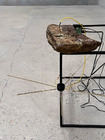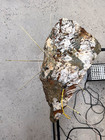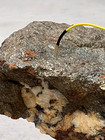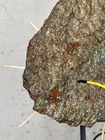Amanda Williams’ (b. 1975) analogue photo-based practice has included mural-scaled silver gelatin hand prints documenting alpine landscapes of high conservation value as well as extensive work with cameraless techniques that expands upon footnotes to the history of photography. When Williams turns to colour, it is not as representation of the world around her but a document of change, the interaction between elements that make up that world. Williams recently completed a major commission for the Powerhouse Sydney for its new Castle Hill archive built on the site of a former eucalyptus plantation. Her two photographs in Free-to-air come from the Powerhouse commission. The Museum of Contemporary Art Australia presented a large body of Williams’ recently acquired mural prints as part of The National: Australian Art Now, in 2023.
For her Lumen Prints, Amanda Williams used a cameraless process to create images of the leaf litter, microorganisms in the soil and surrounding atmosphere of a eucalyptus plantation by placing light-sensitive paper just below the complex ground surface. The silver gelatin paper traditionally used for black & white photographic printing, records a photochemical reaction initiated by light. She describes the physical and material process she engages as haptic - where perception and experience based on touch rather than sight is heightened. A process that invites reflection on time, impermanence and the fragile state of nature, making things unseen and invisible to the human eye seen through this experience of touch. As a final step, the two resulting unfixed lumen prints were photographed with a large-format camera on Kodak Portra 4x5 film and hand printed in the colour darkroom. This additional light exposure and optical enlargement permanently capturing the impermanent state of the lumen print, ecology on the threshold of change.
—adapted from Michael Fitzgerald interview with the artist. Amanda Williams’ works in Free-to-air were commissioned by Powerhouse for Powerhouse Castle Hill.
Jazz Money (b. 1992) is a Wiradjuri artist, poet and filmmaker. Their cross-disciplinary practice speaks to language, narrative and First Nations’ legacies of place. Via agile poetics and moving images Money’s work is an energetic vessel for the oral tradition of story-telling of First Nations cultures which over millennia has been the living instrument of care on and for this continent. Earlier in 2024, Money exhibited in the 18th Adelaide Biennial of Australian Art: Inner Sanctum at the Art Gallery of South Australia. Their first feature film, WINHANGANHA, premiered in 2023 commissioned by the National Film and Sound Archive of Australia. Money has two collections of poetry published by the University of Queensland Press: how to make a basket (2020, winner of the David Unaipon Award) and mark the dawn (2024). Money currently is a One Year Studio Artist at Artspace Sydney. Their three channel video projection infinite iterative piece was exhibited at the Australian Centre for Contemporary Art, Melbourne, as part of the exhibition Between Waves, currently touring regionally.
Three Pieces of Light is a poetic intervention of neon text spread, scattered in a manner to invite audiences on a journey through fragmented lines of poetry. Poetry attunes us to the small spectacle moments of life and teaches us to pay close attention to what can be learnt by observing how light gets in to any given moment. Three Pieces of Light is comprised of three short lines of text that can be read and reread in different formations to give different meanings. Each line asks us to consider the very small and the very large, across images of dawn, stars, song and ‘small spectacular moments’ the words invite their own interpretation for each viewer to understand in their own manner.
—Jazz Money
Joel Sherwood Spring (b. 1992) is a Wiradjuri artist with an academic and professional background in architecture (University of Technology Sydney). His three-dimensional and screen-based works build discourse around the spatial dynamics of power and the material traces of theft enacted by extractive industries as found in the componentry of commercial products. These investigations are presented within a general ethical framework of repatriation and reparation. Sherwood Spring’s work has been exhibited in the Biennale of Sydney (2024) and the 4th National Indigenous Art Triennial: Ceremony at the National Gallery of Australia (2022). In 2024 he spent three months in Saudia Arabia on an AlUla Visual Art Residency and participated in the exhibition Shadow Over Everything at Mabiti Palm Grove, curated by Maryam Bilal. His recent work SETTLED, a satirical wellness app presented as a video projection, is a 2024 Macfarlane Commission currently on exhibition at the Australian Centre for Contemporary Art, Melbourne. Sherwood Spring is currently a Clothing Store Studio Artist at Carriageworks, Sydney.
Burn-ins are media events that compress time when onscreen information remains motionless for extended periods: a condition of image persistence that arrests the movement of light-emitting phosphors that would normally animate its surface. What evidential role could a fogged piece of glass coated in black and grey phosphor dots play in a peace process as visible proof of the powerful events that took place throughout the many years of use? The representational demand to corroborate the contested versions of its history is significant, especially when experiences in space differ.
—Joel Sherwood Spring
David Haines (b. 1966) is an artist with a highly developed and internationally recognised practice that has included exhibitions at the Tate Liverpool and the Nam June Paik Museum. In his work, Haines unpacks celestial, terrestrial and paranormal phenomena with an emphasis on digital, photographic and non-standard technologies including games and aromas. He has twice exhibited in the Biennale of Sydney (2002, 2022) and the São Paulo Biennal (2004). Haines practices as a solo artist and has done extensive collaborative work with Joyce Hinterding. Collaboratively with Hinterding, Haines has twice been shortlisted for the Australia Pavilion at the Venice Biennale. The Museum of Contemporary Art Australia presented an exhibition of Haines and Hinterding’s work in 2015. Later in 2024, Haines and Hinterding are exhibiting at the Guggenheim Gallery at Chapman University, Los Angeles and at the Daejong Museum of Art in South Korea. Haines and Hinterding’s 2011 collaborative work, The Outlands, was awarded the Ann Lander New Media and Video Art Award and is currently on exhibition at the Art Gallery of New South Wales.
Joyce Hinterding (b. 1958) is a leading figure in Australian contemporary art with a practice spanning four decades. Early in her career, emerging from undergraduate studies in silversmithing, Hinterding identified the conductive potential of graphite drawings thereby combining the foundations of fine art and the basics of electronics. Hinterding has received high international recognition for her artworks that explore energetic forces. Energy as an artistic medium is harnessed by Hinterding via objects that are simultaneously characteristic of jewellery, sculpture and electronic circuitry. Hinterding practices as a solo artist and has done extensive collaborative work with David Haines. She has three times exhibited in the Biennale of Sydney (1992, 2002, 2022) and the São Paulo Biennal (2004). Collaboratively with David Haines, Hinterding has twice been shortlisted for the Australia Pavilion at the Venice Biennale. The Museum of Contemporary Art Australia presented an exhibition of Haines and Hinterding’s work in 2015. Later in 2024, Hinterding and Haines are exhibiting at the Guggenheim Gallery at Chapman University, Los Angeles and at the Daejong Museum of Art in South Korea.
Chunks of Chalcopyrite (copper ore from Queenstown, Tasmania) function as speculative antennae floating on welded frames, forming part of a circuit that offers a unique perspective on the free-to-air broadcast. We are able to view TV broadcasts in ways that we don’t usually see—patterns in the margins of the signal, where the transmissions are spectral and ghostly. A tiny television receiver and computer allow us to tune conductive elements in the stone that bring the electromagnetic broadcast energies to the surface. If television and its world reportage seem entirely unreal, our form of sculptural TV returns this state of being back to an inhabitation of the real and the contemplation of how all things exist beyond the subject. By tuning these rocks to Channel 9, 10 and 7, the opinions and soap opera drama of talking heads become demodulated and quietened into something beautiful and fundamental, simply what they always have been: aesthetic waves of electromagnetism.
—David Haines and Joyce Hinterding





















